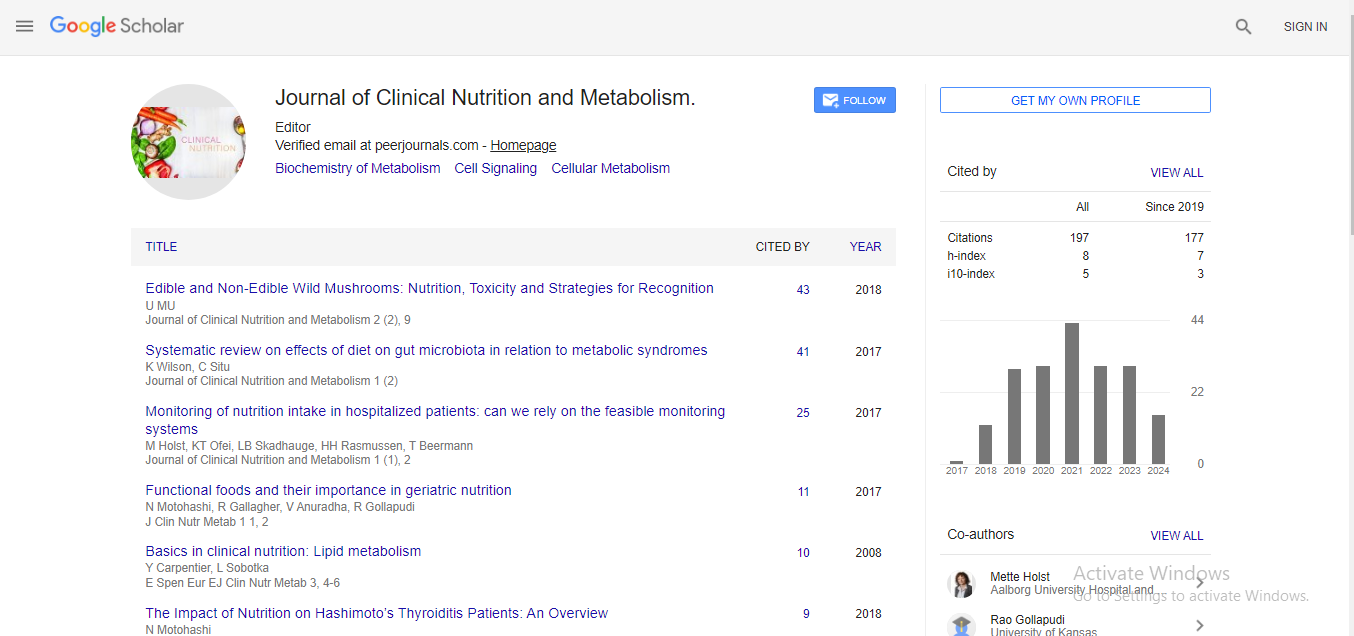Opinion Article, J Clin Nutr Metab Vol: 7 Issue: 2
Brown Adipose Tissue: Solving its Role in Energy Expenditure and Thermogenesis
Mitsuo Hamada*
1Department of Therapeutic Nutrition, Institute of Biomedical Sciences Tokushima University, Kuramoto-Cho, Tokushima, Japan
*Corresponding Author: Mitsuo Hamada,
Department of Therapeutic Nutrition,
Institute of Biomedical Sciences Tokushima University, Kuramoto-Cho, Tokushima,
Japan
E-mail: hamadamit@tokushima-u.ac.jp
Received date: 22 May, 2023, Manuscript No. JCNM-23-106825;
Editor assigned date: 24 May, 2023, Pre QC. JCNM-23-106825 (PQ);
Reviewed date: 07 June, 2023, QC No. JCNM-23-106825;
Revised date: 15 June, 2023, Manuscript No. JCNM-23-106825 (R);
Published date: 22 June, 2023, DOI: 10.35841/jcnm.1000116.
Citation: Hamada M (2023) Brown Adipose Tissue: S olving its Role in Energy Expenditure and Thermogenesis . J Clin Nutr Metab 7:2.
Abstract
Brown Adipose Tissue (BAT) is a specialized type of adipose tissue that plays a significant role in energy expenditure and thermogenesis. Unlike white adipose tissue (WAT), which primarily stores energy as triglycerides, BAT is rich in mitochondria and contains high levels of Uncoupling Protein 1 (UCP1), enabling it to dissipate energy as heat. This brief study aims to explore the role of brown adipose tissue in energy expenditure and thermogenesis, highlighting its potential implications for metabolic health.
Keywords: Brown Adipose Tissue
Description
Brown Adipose Tissue (BAT) is a specialized type of adipose tissue that plays a significant role in energy expenditure and thermogenesis. Unlike white adipose tissue (WAT), which primarily stores energy as triglycerides, BAT is rich in mitochondria and contains high levels of Uncoupling Protein 1 (UCP1), enabling it to dissipate energy as heat. This brief study aims to explore the role of brown adipose tissue in energy expenditure and thermogenesis, highlighting its potential implications for metabolic health.
Brown adipose tissue and thermogenesis
Brown adipose tissue is characterized by its thermogenic properties, primarily driven by the expression of UCP1 in its mitochondria. UCP1 uncouples oxidative phosphorylation from ATP synthesis, leading to the dissipation of energy as heat instead of ATP production. This process, known as non-shivering thermogenesis, allows BAT to generate heat in response to cold exposure or sympathetic nervous system activation. Thermogenesis in BAT is fueled by the breakdown of stored lipids and glucose, which are metabolized to produce heat.
Regulation of brown adipose tissue activity
The activity of brown adipose tissue is tightly regulated by various factors. Cold exposure is a potent stimulator of BAT activation, triggering sympathetic nervous system activation and the release of norepinephrine. Norepinephrine binds to adrenergic receptors on BAT cells, leading to the activation of thermogenic pathways. Other factors, such as exercise, certain hormones (e.g., thyroid hormones, irisin), and dietary components (e.g., capsaicin), can also influence BAT activity. Emerging research suggests that the microbiome and gut-derived signals may play a role in modulating BAT activity, highlighting the complex regulation of this tissue.
Brown adipose tissue and energy expenditure
The thermogenic activity of brown adipose tissue contributes to overall energy expenditure. BAT activation increases whole-body energy expenditure, as heat generation requires the utilization of stored lipids and glucose. Studies have shown that individuals with higher BAT activity exhibit increased resting energy expenditure and improved metabolic health. Harnessing the thermogenic potential of BAT has garnered interest as a potential therapeutic target for the prevention and treatment of obesity and metabolic disorders.
Brown adipose tissue in humans
While brown adipose tissue was initially believed to be primarily present in infants, recent studies have demonstrated its presence and activity in adult humans. BAT is predominantly found in the supraclavicular, neck, and paravertebral regions. Factors such as age, sex, body composition, and environmental conditions can influence the amount and activity of BAT. Cold exposure, even mild cold exposure, can stimulate BAT activation in humans. The discovery of BAT in adult humans has led to increased interest in understanding its physiological functions and therapeutic potential in modulating energy metabolism.
Implications for metabolic health and obesity
The role of brown adipose tissue in energy expenditure and thermogenesis has significant implications for metabolic health and obesity. BAT activation can enhance glucose and lipid metabolism, improving insulin sensitivity and lipid profiles. Studies have shown that individuals with higher BAT activity exhibit lower body mass index, reduced adiposity, and improved metabolic parameters. Conversely, impaired BAT activity or reduced BAT volume is associated with obesity and metabolic dysfunction. Strategies aimed at enhancing BAT activity, such as cold exposure, pharmacological interventions, or lifestyle modifications, are being explored as potential approaches to combat obesity and metabolic disorders.
Future directions and therapeutic potential
Further research is needed to unravel the full potential of brown adipose tissue in metabolic health and develop strategies to harness its thermogenic capacity. Identifying novel regulators of BAT activity, elucidating the interplay between BAT and other tissues, and understanding the mechanisms underlying BAT dysfunction in obesity are areas of active investigation. Therapeutic interventions aimed at enhancing BAT activity or inducing "browning" of white adipose tissue hold promise as potential strategies for metabolic health improvement and obesity management.
Conclusion
Brown adipose tissue represents a unique metabolic tissue with remarkable thermogenic properties. Its ability to dissipate energy as heat contributes to energy expenditure and has implications for metabolic health. Understanding the regulation of brown adipose tissue activity, its role in energy metabolism, and its potential as a therapeutic target in obesity and metabolic disorders is an area of ongoing research. By unraveling the mechanisms underlying brown adipose tissue function, it may uncover new strategies to enhance energy expenditure and combat metabolic dysfunction, paving the way for potential therapeutic interventions.
 Spanish
Spanish  Chinese
Chinese  Russian
Russian  German
German  French
French  Japanese
Japanese  Portuguese
Portuguese  Hindi
Hindi 